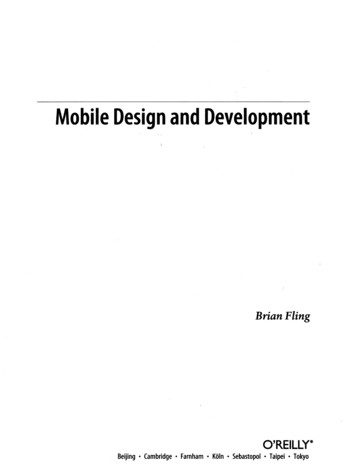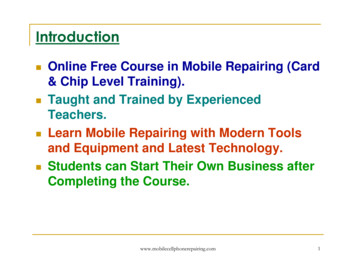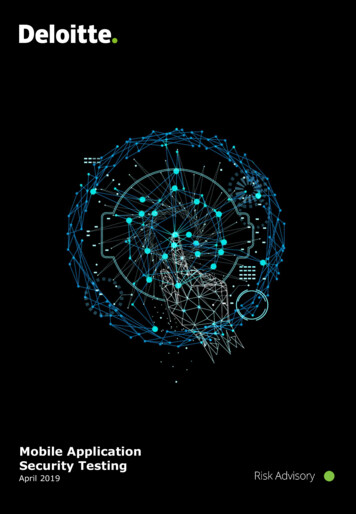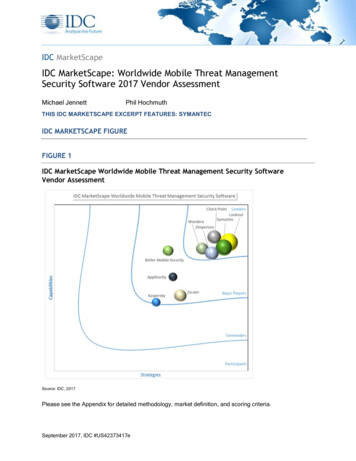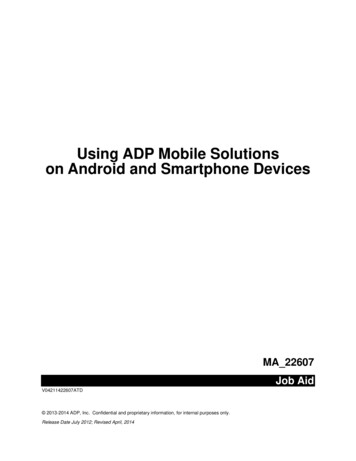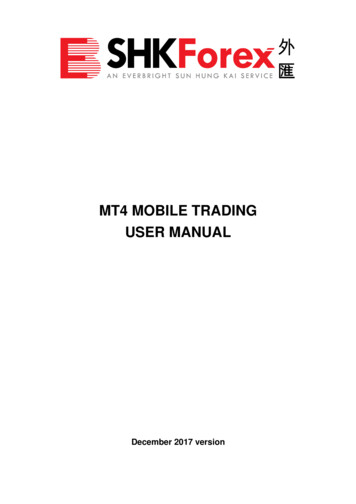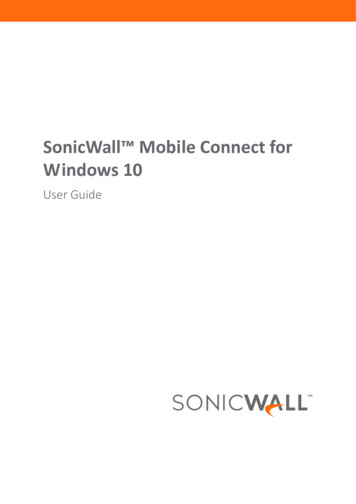
Transcription
CONOR HANRAHAN, PharmD, BCPSMedical University of South CarolinaSouth Carolina College of PharmacyCharleston, South CarolinaTIMOTHY DY AUNGST, PharmDMCPHS University School of PharmacyWorcester, MassachusettsSABRINA COLE, PharmD, BCPSWingate University School of PharmacyLevine College of Health SciencesWingate, North Carolina
Any correspondence regarding this publication should be sent to the publisher, American Society of HealthSystem Pharmacists, 7272 Wisconsin Avenue, Bethesda, MD 20814, attention: Special Publishing.The information presented herein reflects the opinions of the contributors and advisors. It should not beinterpreted as an official policy of ASHP or as an endorsement of any product.Because of ongoing research and improvements in technology, the information and its applications containedin this text are constantly evolving and are subject to the professional judgment and interpretation of thepractitioner due to the uniqueness of a clinical situation. The editors and ASHP have made reasonable effortsto ensure the accuracy and appropriateness of the information presented in this document. However, any userof this information is advised that the editors and ASHP are not responsible for the continued currency of theinformation, for any errors or omissions, and/or for any consequences arising from the use of the informationin the document in any and all practice settings. Any reader of this document is cautioned that ASHP makesno representation, guarantee, or warranty, express or implied, as to the accuracy and appropriateness of theinformation contained in this document and specifically disclaims any liability to any party for the accuracy and/or completeness of the material or for any damages arising out of the use or non-use of any of the informationcontained in this document.Director, Special Publishing: Jack BruggemanAcquisitions Editor: Robin ColemanEditorial Project Manager: Ruth BloomProduction Manager: Kristin EcklesCover and Page Design: David Wade and Carol Barrer 2014, American Society of Health-System Pharmacists, Inc. All rights reserved.No part of this publication may be reproduced or transmitted in any form or by any means, electronic ormechanical, including photocopying, microfilming, and recording, or by any information storage and retrievalsystem, without written permission from the American Society of Health-System Pharmacists.ASHP is a service mark of the American Society of Health-System Pharmacists, Inc.; registered in the U.S.Patent and Trademark Office.ISBN: 978-1-58528-458-0
4Evaluating Mobile Medical ApplicationsCONTENTSIntroductionRise of Mobile Applications (Apps)Table 1: Key terms and definitionsFigure 1: Number of apps by operating systemSmart Devices and MedicineRelevance to Pharmacy PracticeMobile Medical Apps in Clinical PracticeDangers and Pitfalls of Mobile Medical AppsRegulation of Mobile Medical AppsTable 2: FDA regulation of medical appsApproach to Critiquing Medical AppsTraditional Methods for Critiquing ResourcesTable 3: HONcode’s 8 principles for certification of websitesFigure 2: HONcode seal of approvalTable 4: AHRQ criteria for evaluating health information on the InternetEvaluating Mobile Medical AppsFigure 3: Common information icons used in mobile appsFigure 4: Obtaining details about mobile appsFigure 5: Assessing the design of mobile appsTools for Evaluating Mobile Medical AppsTable 5: Rubric for evaluating mobile drug information appsTable 6: Checklist for evaluating mobile drug information and medical reference appsTable 7: Checklist for evaluating mobile medical calculatorsSummaryReferencesAnnotated Outside SourcesAppendix 1: Worksheet for Evaluating Mobile Medical AppsINTRODUCTIONWithin the past decade, great strides have been made in the advancement of mobile devices. While theearly part of the decade saw the rise of personal digital assistants (PDAs) and mobile phones, recentadvancements have led to an evolution of mobile devices into so called smart devices (e.g., smartphones,tablet computers) with further features not present before. Several factors helped contribute to this change,including increased processing power, greater memory storage, a reduction in the size of components, andlower costs to consumers. In addition, cellular services have greatly increased along with the availability ofInternet connections through Wi-Fi networks, allowing greater access to information on the Internet viasmart devices. Furthermore, most smart devices now incorporate sensors such as accelerometers, globalpositioning satellite components, and cameras, which have greatly impacted their scope and utilization.Taking into consideration the technical growth of smart devices, many products are now capitalizingon mobile software applications (apps). These apps are tailored to a specific mobile platform and allowusers to perform actions that use one or many functions built into the smart device. Such apps enable usersto engage in forms of social media; pursue leisure activities (e.g., photography, shopping, travel, dining);
Evaluating Mobile Medical Applications5assist with everyday tasks (e.g., calendars, event planning, navigation); and much more. Many companieshave also recognized the ability to use apps as both a marketing tool and to enhance services provided totheir customers. As such, smart devices are no longer relegated as merely a direct communication tool butas a source of social engagement and personal productivity. Table 1 describes some of the key terms andconcepts associated with smart devices.Rise of Mobile AppsThe current market of mobile apps is reliant on the operating system (OS) associated with the device. Themost widely adopted systems are Apple’s iOS, Google’s Android OS, Windows Mobile, and Blackberry.Each system supports their own native and third-party apps available from the device’s mobile app store(e.g., iTunes , Google Play ). Although some apps are available across systems, others are specific to aparticular OS. Current data demonstrate a significant amount of mobile apps available on the market, asseen in Figure 1.The Apple iTunes and Android Google Play stores currently lead the market in terms of availableapps, with Windows and Blackberry having the least amounts of apps. With respect to mobile medicalapps, the marketplace is again dominated by iTunes and Google Play , both of which have a medicalcategory. Although the true number of mobile medical apps is not currently known, data suggest that moreof these apps are available on the iTunes store compared with its competitors. This market share is due,in part, to the fact that Apple’s iOS was the first novel mobile app supportive device and was adopted earlyby those in the medical field.Smart Devices and MedicineThe medical field has always had an interest in the incorporation of technological advances into practice.Many early adopters of PDAs sought to evaluate their impact on clinical care as a medical reference. Severalstudies throughout the early twenty-first century evaluated the benefits of mobile devices as a way toincrease communication, improve access to the medical literature, and streamline productivity and clinicalworkflow.1-9 At the time, ownership of such devices was rather limited due to their price and functionality.Table 1: Key terms and definitionsTermDefinitionMobile application (app)Software for use on a mobile platformNative mobile appMobile app that comes equipped on a device (e.g., contacts, camera)Downloadable mobile appMobile apps that are developed by third-party organizations and then downloaded to thedevice hardwareMobile deviceA handheld computing device characterized by a touch-screen display for input,streamlined operating system, and appsSmartphoneSmall portable mobile device focused on communication through messaging andvoice-to-voice communication supported by cellular servicesShort messaging service (SMS)Services dedicated toward communication through messages consisting of text(i.e., texting)Social mediaNetworks of communication focused on electronic interactions between users wherecontent is shared, created, and ideas exchangedOperating system (OS)Overarching device software that manages its memory, processes, and overallperformanceMobile storeOnline store where mobile apps may be purchased and downloaded to the device
6Evaluating Mobile Medical ApplicationsTotal Number of 0AppleGoogleWindowsBlackBerryFigure 1: Total numberof apps by operatingsystem**Data current through December 1, 2013.It was also relegated to those institutions that purchased such devices for their members or relied on usersto bring their own devices. However, with the advent of recent smart devices, there has been a renewedinterest in the implication of mobile devices as an adjunctive tool in medical practice.10-13Similarly, the practice of pharmacy has been interested in the utilization of mobile devices. Notably,several studies published in the early 2000s sought to identify the quality of information dealing withmedication references in comparison with the currently available infrastructure.1-3,14-16 Early adopters founda means to replace the encumbering amount of printed literature on drug information with data that couldbe compressed into an easily accessible handheld device. In addition, a portable means of documentinginterventions by clinical pharmacists via mobile devices was also further investigated.6-9 Today, smart devicesand their concomitant apps offer further opportunities in clinical practice for pharmacists.RELEVANCE TO PHARMACY PRACTICEMobile Medical Apps in Clinical PracticeMobile medical apps fulfill multiple roles, often taking advantage of built-in features found within smartdevices. For instance, the amount of clinical information that can be stored on smart devices is substantial,with many offering 8 to 64 gigabytes of internal memory. In addition, storage space is enhanced by theavailability of cloud computing, whereby content can be stored on external servers and then accessed directlyfrom the mobile device. With such availability, many companies of clinical information have created appsand electronic books that enhance already existing product information for use on a mobile device screen.Incorporation of other sensors on mobile devices, such as a camera, has also been used to help captureand share clinical images.17 Several developers are exploring the use of the camera and augmented realitytechnology as a means to conduct diagnostic activities, such as evaluating a skin mole for melanoma. Anotherongoing project includes utilizing the camera of a smart device to conduct pill identification. Apps are alsocreating novel ways to communicate among health care professionals, while safeguarding patient healthinformation and allowing members to have ongoing relationships similar to social media.
Evaluating Mobile Medical Applications7Furthermore, many companies and hospitals are investing in apps to serve as patient education tools,incorporating videos and touch-based teaching methods. Additionally, mobile apps are being used in theeducation of medical students through the use of quizzes and virtual flashcards. They are also being utilizedas digital simulations of clinical situations or surgical interventions, taking advantage of the touch-baseddisplay on the smart device. Some examples include demonstration of orthopedic surgical techniques orcardiac interventions, such as coronary artery bypass surgery, in order to show a patient what will be done.In addition to mobile apps functioning as standalone elements, many upcoming mobile apps areintegrating with other peripheral devices. In fact, several companies are creating patient-centric ambulatorymonitoring tools to be used in the outpatient setting. These apps capitalize on the ability of smart devicesto synchronize with other peripheral devices or systems via Bluetooth (e.g., motor vehicle, scales, watches).Such peripheral devices include health fitness trackers, blood pressure cuffs, glucose monitors, heart monitors,and medication adherence systems. These devices record outpatient vitals, which can be then shared withhealth care professionals on a regular basis.Pharmacy practice stands to benefit from the diversity of mobile medical apps and associated peripheraldevices as a new means to enhance daily clinical activities and patient care. Future research will investigatethe utilization of mobile apps to improve patient health through diet and exercise trackers, and as waysto increase medication adherence. The integration of apps and their ability to track data in the outpatientsetting may pose a significant boon to ambulatory care pharmacists working with patients that requirechronic monitoring. These apps may also play an integral role in the rise of telemedicine activities. Inaddition, studies have identified the use of mobile apps as a means to enhance pharmacists’ access to theliterature and medication information.1-3,5,14,15This veritable explosion in mobile medical apps may poise itself to help medical professionals in allranges of practice; however, there have been significant issues leading to questions about the legitimacyof medical apps.Dangers and Pitfalls of Mobile Medical AppsWith the huge inroads smart devices have made into society and the medical field, researchers have begunto evaluate the quality, efficacy, and safety of their apps. While initial reports suggested that there weremany benefits to using apps in clinical practice,18,19 there have also been studies and reports detailing theirnumerous shortcomings.20-24One of the most galling issues that pose the most significant risk to the public is apps that falsely claimto help cure or modify a disease. One early instance occurred in 2011, when a company created an appmeant to cure acne by emitting a blue light from the screen of a smartphone. At the time, there were over10,000 downloads for the app, which sold for 1.99 on the iTunes and Google Play store. The FederalTrade Commission (FTC) stepped in and stopped all marketing of the product and the app quickly disappeared from the app stores.25 Although no patient was ever harmed by the product, it is troubling that suchan app was able to make it to market without proof of efficacy.Perhaps the next significant risk mobile medical apps may pose is the accuracy of their diagnostic abilities.Currently, there are numerous apps on the market that claim to analyze moles and determine the risk ofmelanoma using the built-in camera of a smartphone. In a recent study, Wolf and colleagues evaluated severalof these dermatology apps and found a startling sensitivity range of 6.8% to 98% and specificity range of30.4% to 93.7%.26 Several other studies have also shown similar results.27,28 This wide range of accuracy isconcerning for the overall industry of mobile medical apps and may pose a significant risk to patients.
8Evaluating Mobile Medical ApplicationsWhile apps used for diagnosing disease may pose a more immediate danger to patients, there are alsonoted issues with the overall quality of medical apps in general. One serious issue has been a focus on theinformation provided by apps. Many investigators have found that some third-party developers do not citeor provide references for the content included in the app. In one study investigating the source of information provided in apps related to cancer, the authors found that less than half actually cited their sourceof information.29 Another study evaluating the reliability of opioid conversion apps found that only halfof the apps evaluated cited the source of their dose conversion guides.30 The significance of these studiesdemonstrates that, while apps may be beneficial to keep as a medical reference, the quality of informationfound within them could pose a risk to patient care.Along with the quality of information found within an app, there is cause for concern when dealingwith those who created the app. Similar to other areas of medicine, it is often important to demonstrate thatthe author has the clinical knowledge to present quality information. For that reason, it is surprising andconcerning to find that many medical apps are either created by people with no medical training, or do notinclude the background of the creator.31 In one study of apps related to vascular surgery, only 27% of theapps reported that a medical professional was involved with its development.32 There have also be severaldocumented instances of plagiarism within medical apps, where a developer has simply taken informationfrom a textbook and transposed it into an app without permission. Several of these cases have been takento court, though the issue remains that this may occur due to lack of oversight.33Regulation of Mobile Medical AppsDespite the potential dangers associated with mobile medical apps, most do not undergo formal reviewor evaluation before entering the market. Currently, most developers must first submit their program forreview by the app store (e.g., iTunes , Google Play ). Although a review process is conducted to ensurethe app is functional and has no major technical issues, the clinical content in medical apps is not assessed.As such, it is understandable that many apps of lesser quality can slip through the review process. Whilethis lack of review by those responsible for the app marketplace is concerning, there is also a general lackof federal oversight. In fact, the federal regulation of most software products has proven to be difficult dueto their complexity and diversity.Historically, software products intended for use in the diagnosis or treatment of disease have beenclassified as a medical device by the U.S. Food and Drug Administration (FDA). The regulation of medicaldevices differs from that of drugs since it is based on a three-tier classification system. Specifically, devicesare designated as either Class I, II, or III, depending on their potential risk. Class I devices are considered tobe the lowest risk and are generally exempt from FDA review. Class II devices, however, are considered anintermediate level of risk and developers are usually required to submit a premarket notification (or 510[k]notification). Under this process, developers must show that the product is “substantially equivalent” to asimilar device already on the market. Class III devices are considered to be the highest risk level and mustgenerally undergo a more complex, time-consuming, and expensive premarket approval process.34The regulation of medical apps was not specifically addressed until 2011, when the FDA released adraft guidance on the topic. The guidance, which was updated and finalized in September 2013, outlineshow the FDA will apply its regulatory authority to mobile medical apps.35 Table 2 summarizes the types ofapps that the FDA intends to regulate. In brief, oversight will apply only to a small subset of medical appsthat the FDA considers to be high risk if it does not function as intended. These include apps designedto control other medical devices (e.g., an app that controls the delivery of insulin on an insulin pump) aswell as apps that display, store, analyze, or transmit patient-specific data from another medical device (e.g.,
Evaluating Mobile Medical Applications9Table 2: FDA regulation of medical apps35Regulated apps Control other medical devices Display, store, analyze, or transmit patient-specific medical data from another device Use attachments, display screens, or sensors to transform the mobile platform into a medical device Perform patient-specific analysis and provide a patient-specific diagnosis or treatment recommendationApps subject to enforcement discretion Provide or facilitate supplemental care by coaching or prompting patients Tools to help patients organize or track health information Provide access to information related to health conditions or treatments Allow patients to communicate medical conditions with providers Perform simple calculations used in clinical practice Enable individuals to interact with electronic health recordsApps that will not be regulated Electronic copies of medical textbooks, teaching aids, or other reference materials Intended as educational tools for medical training Facilitate patient access or understanding Automate general office operations Not specifically designed or intended for medical purposesan app that displays live data from a bedside monitor). In addition, the FDA will also apply oversight toapps that use attachments to transform the mobile platform into an already regulated medical device (e.g.,attachment of a glucose strip reader to transform the mobile platform into a blood glucose meter). Lastly,apps that perform sophisticated analysis of patient-specific data to provide a patient-specific diagnosis ortreatment recommendation will also be subject to regulation (e.g., an app that uses patient data to createa dosage regimen for radiation therapy).35The guidance also discusses the types of apps for which the FDA plans to exercise “enforcementdiscretion,” meaning that their regulatory authority would not be applied except in special circumstances(Table 2). This category mainly includes patient-oriented apps, such as those that help patients track andmanage health information. Unfortunately, this category also includes many of the medical apps used bypharmacists and other clinicians in daily practice. For example, the FDA will not regulate apps that providecontextually-relevant access to medical information used in clinical practice (e.g., apps that check fordrug–drug or drug–allergy interactions). Similarly, the FDA will not review apps that provide clinicianswith a summary of best practice guidelines or other therapy recommendations for a particular medicalcondition (e.g., an app presenting a contextually-relevant antibiotic treatment algorithm based on site ofinfection). Mobile medical calculators are another type of commonly used app for which the FDA willexercise enforcement discretion. As such, programs used to calculate creatinine clearance, body mass index,CHADS2 score, etc., are not subject to FDA review.35 Given that many of these apps are used to assist withtreatment decisions (e.g., determining drug choice, drug dose), it is concerning that developers will not beheld accountable for the quality and accuracy of the information provided.In addition to guidance from the FDA, the FTC has released a guide to help mobile app developersremain truthful in advertising and basic privacy principles. Specifically, they suggest that developers avoidmaking false or misleading claims, avoid omitting important details in advertisements, and have “competent
10Evaluating Mobile Medical Applicationsand reliable evidence” that the app functions as intended. Disclosures should also be clear and transparent,as should any data practices regarding privacy (e.g., collecting and sharing user information).36Although the FTC has made a concerted effort to address deceptive and unfair practices surroundingmobile technology, they are unable to proactively review the large influx of medical apps entering themarketplace. Similarly, as of November 2013, only 100 of the over 10,000 medical apps available on themarketplace were cleared by the FDA.37 As such, it is obvious that clinicians cannot rely on governmentoversight alone to ensure the safety of mobile apps. Considering the potential dangers, it is imperative thatindividual users possess the knowledge and skill needed to evaluate these programs.APPROACH TO CRITIQUING MEDICAL APPSTraditional Methods for Critiquing ResourcesThe concept of critiquing electronic medical resources has been around for years, originating with variousquality initiatives for evaluating health information on the Internet. In 2002, the Institute of Medicinelikened the Internet to the “Wild West” stating “it has vast amounts of unregulated territory and no one incharge.”38 In many ways, the growing landscape of mobile medical apps, and the concerns regarding thequality of information, parallels this Wild West mentality. As such, it may be helpful to adapt and applythe criteria for evaluating Internet resources to mobile apps.39One of the most well-known evaluation tools for Internet resources is the Health on the Net Foundation(HON). First established in 1995, HON was founded to support the access of health information to patientsand health care professionals via the Internet.40 The original HON Code of Conduct (HONcode), publishedin 1996, was intended to enhance the quality of information available, and the current version of the codewas published in 1997. The HONcode for medical and health websites consists of the following eightprinciples: authority, complementarity, confidentiality, attribution, justifiability, transparency, financialdisclosure, and advertising. Detail on each principle is provided in Table 3.Upon request, websites determined to adhere to these eight principles are awarded the HONcode seal(see Figure 2) for placement on the site. HON also performs regular monitoring of certified sites to ensurecompliance with the code. The presence of the HONcode seal is a sign to users that the website publisheradheres to an ethical standard. It is important to consider that the seal does not ensure the accuracy of allinformation contained on the site, nor does it replace the need for professional judgment to apply health information to a particular patient. With the vast amounts of health information on the Internet and the assuranceof continued growth in this area, users must employ critical appraisal of the information found. Criteria andquestions have been posed by various organizations that allow users to conduct such critical assessment.Table 3: HONcode’s 8 principles for certification of websites40AuthorityGive qualifications of authorsComplementarityInformation to support, not replaceConfidentialityRespect the privacy of site usersAttributionCite the sources and dates of medical informationJustifiabilityJustification of claims/balanced and objective claimsTransparencyAccessibility, provide valid contact detailsFinancial disclosureProvide details of fundingAdvertisingClearly distinguish advertising from editorial content
Evaluating Mobile Medical Applications11The Agency for Healthcare Research and Quality (AHRQ) also provides support for Internet users tocritically evaluate health information on the Internet.41 The criteria proposed by AHRQ include credibility,content, disclosure, links, design, interactivity, and caveats. These criteria reinforce the need for health information to be current, relevant, accurate, thorough, well-organized, and nonbiased. Additional descriptionfor each of these criteria is detailed in Table 4.Several other quality initiatives for evaluating Internet resources have been published to help addressthe concerns with the quality of information on the Web.42 Although a review of every Internet evaluationtool is beyond the scope of this article, the following key questions have been shown to be useful whenevaluating a website43,44: Who runs the website? What is the purpose of the website? Who is responsible for the information? How is the information documented? What are the credentials of the contributions or reviewers? Is the information current? What is the website’s linking policy? What is the website’s privacy policy? Is contact information readily available? Who monitors the chat room (if available)?Figure 2: HONcode seal of approval40Table 4: AHRQ criteria for evaluating health information on the Internet41CredibilityIncludes the source, currency, relevance/utility, and editorial review process for the informationContentMust be accurate and complete, and an appropriate disclaimer providedDisclosureIncludes informing the user of the site’s purpose, as well as any profiling or collection of informationassociated with using the siteLinksEvaluated according to selection, architecture, content, and back linkagesDesignEncompasses accessibility, logical organization (navigability), and internal search capabilityInteractivityIncludes feedback mechanisms and means for exchange of information among usersCaveatsClarification of whether site’s function is to market products and services or is a primary informationcontent provider
12Evaluating Mobile Medical ApplicationsThus, the evaluation of information on the Internet requires a critical assessment of the integrity of thecontent, careful examination and attention to the source, and a detailed appraisal of the intent for disseminating the information. Fortunately, these same guiding principles can serve as a foundation for assessingthe credibility, accuracy, and intent of mobile apps.Evaluating Mobile Medical AppsMobile medical apps come in a variety of forms, each with their own unique purpose. As such, the evaluation of medical apps must vary based on the specific product in question. For example, an app designedto provide antibiotic recommendations for the treatment of pneumonia is very different than one designedto measure a patient’s blood glucose levels. With the antibiotic app, one might be interested in evaluatingthe clinical references used to support treatment recommendations; however, when evaluating the bloodglucose app, one might be more interested in evaluating aspects related to operability. Nevertheless, mostapps can be evaluated based on several common principles including their usefulness, accuracy, authority,objectivity, timeliness, functionally, design, security, and value.Usefulness. One of the first things to consider when evaluating a medical app is its overall usefulnessin a particular practice setting. Ideally, apps should help improve one’s efficiency and knowledgebase. Anapp that is truly useful should make life easier and help streamline job responsibilitie
Mobile application (app) Software for use on a mobile platform Native mobile app Mobile app that comes equipped on a device (e.g., contacts, camera) Downloadable mobile app Mobile apps that are developed by third-party organizations and then downloaded to the device hardware Mobile device
